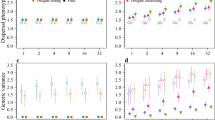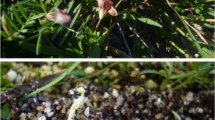Abstract
The question Why to disperse? has been extensively investigated from an evolutionary perspective, and the strategy to disperse can be explained by several proximate and ultimate factors. The amazing diversity of dispersal mechanisms that animals, plants, fungi, peat mosses and other organisms have developed leads to the following question: How to disperse? In this article, we introduce an original modeling framework to study the evolution of dispersal in asexual populations where reproducing individuals release propagules and can adopt (by mutation) three strategies: independent movements of all propagules, clump dispersal (i.e. clumps of propagules attached together and settling at the same location), or group dispersal (i.e. groups of propagules simultaneously released and settling at different but positively correlated locations). We show how the spatial limits and fragmentation of the species’ habitat shape the frequencies of the three strategies in the population and the sizes of groups and clumps. The co-existence of the independent, clump and group dispersal strategies at the stationary state of the population dynamics is of particular note. However, group dispersal never appeared as a dominant strategy, whereas independent and clump dispersal were both dominant for different parameter ranges (essentially because dispersal is either adaptive or maladaptive) .





Similar content being viewed by others
References
Aylor DE, Ferrandino FJ (1986) Germination of urediniospore clusters of Uromyces appendiculatus and Puccinia recondita. Trans Br Mycol Soc 86:591–595
Branch LC, Villareal D, Fowler GS (1993) Recruitment, dispersal, and group fusion in a declining population of the plains vizcacha ( Lagostomus maximus; Chinchillidae). J Mammal 74:9–20
Broquet T, Viard F, Yearsley JM (2012) Genetic drift and collective dispersal can result in chaotic genetic. Evolution 67:1660–1675
Bullock JM, Shea K, Skarpaas O (2006) Measuring plant dispersal: an introduction to field methods and experimental design. Plant Ecol 186:217–234
Clark JS, Silman M, Kern R, Macklin E, HilleRisLambers J (1999) Seed dispersal near and far: patterns across temperate and tropical forests. Ecology 80:1475–1494
Coluccio A, Neiman AM (2004) Interspore bridges: a new feature of the Saccharomyces cerevisiae spore wall. Microbiology 150:3189–3196
Couzin ID, Krause J, James R, Ruxton GD, Franks NR (2002) Collective memory and spatial sorting in animal groups. J Theor Biol 218:1–11
Fernandez AA, Hance T, Deneubourg JL (2012) Interplay between Allee effects and collective movement in metapopulations. Oikos 121:813–822
Gandon S (1999) Kin competition, the cost of inbreeding and the evolution of dispersal. J Theor Biol 200:345–364
Gandon S, Michalakis Y (1999) Evolutionarily stable dispersal rate in a metapopulation with extinctions and kin competition. J Theor Biol 199:275–290
García C, Grivet D (2011) Molecular insights into seed dispersal mutualisms driving plant population recruitment. Acta Oecol 37:632–640
Gould SJ, Lewontin RC (1979) The spandrels of San Marco and the Panglossian paradigm: a critique of the adaptationist programme. Proc R Soc B Biol Sci 205(1161):581–598
Grivet D, Robledo-Arnuncio JJ, Smouse PE, Sork VL (2009) Relative contribution of contemporary pollen and seed dispersal to the effective parental size of seedling population of California valley oak (Quercus lobata, Née). Mol Ecol 18:3967–3979
Gross KL (1984) Effects of seed size and growth form on seedling establishment of six monocarpic perennial plants. J Ecol 72:369–387
Guttal V, Couzin ID (2010) Social interactions, information use, and the evolution of collective migration. Proc Natl Acad Sci USA 107:16,172–16,177
Hamilton WD, Lenton TM (1998) Spora and Gaia: how microbes fly with their clouds. Ethol Ecol Evol 10(1):1–16
Howe HF (1989) Scatter- and clump-dispersal and seedling demography: hypothesis and implications. Oecologia 79:417–426
Hughes J, Allen RC, Baguelin M, Hampson K, Baillie GJ, Elton D, Newton JR, Kellam P, Wood JL, Holmes EC, Murcia PR (2012) Transmission of equine influenza virus during an outbreak is characterized by frequent mixed infections and loose transmission bottlenecks. PLoS Pathog 8:e1003,081
Ingold CT (1971) Fungal spores. Their liberation and dispersal. Oxford University Press, Oxford
Jackson ST, Lyford ME (1999) Pollen dispersal models in quaternary plant ecology: assumptions, parameters, and prescriptions. Bot Rev 65:39–75
Karubian J, Sork VL, Roorda T, Durães R, Smith TB (2010) Destination-based seed dispersal homogenizes genetic structure of a tropical palm. Mol Ecol 19:1745–1753
Klein EK, Lavigne C, Foueillassar X, Gouyon PH, Larédo C (2003) Corn pollen dispersal: quasi-mechanistic models and field experiments. Ecol Monogr 73:131–150
Martin MD, Chamecki M, Brush GS, Meneveau C, Parlange MB (2009) Pollen clumping and wind dispersal in an invasive angiosperm. Am J Bot 96:1703–1711
McAtee WL (1917) Showers of organic matter. Mon Weather Rev 45:217
Murrell DJ, Travis JMJ, Dytham C (2002) The evolution of dispersal distance in spatially-structured populations. Oikos 2:229–236
Olivieri I, Michalakis Y, Gouyon PH (1995) Metapopulation genetics and the evolution of dispersal. Am Nat 146:202–228
Pacini E, Franchi GG (1999) Pollen grain sporoderm and types of dispersal units. Acta Soc Bot Pol 68:299–305
Pazos GE, Greene DF, Katul G, Bertiller MB, Soons MB (2013) Seed dispersal by wind: towards a conceptual framework of seed abscission and its contribution to long-distance dispersal. J Ecol 101:889–904
Pizo MA, Simão I (2001) Seed deposition patterns and the survival of seeds and seedlings of the palm Euterpe edulis. Acta Œcologica 22:229–233
R Core Team (2014) R: a language and environment for statistical computing. R Foundation for Statistical Computing, Vienna, Austria, http://www.R-project.org
Rapilly F (1979) Yellow rust epidemiology. Ann Rev Phytopathol 17:59–73
Ravigné V, Olivieri I, Martinez SG, Rousset F (2006) Selective interactions between short-distance pollen and seed dispersal in self-compatible species. Evolution 60:2257–2271
Reichling SB (2000) Group dispersal in juvenile Brachypelma vagans (Aranae, Theraphosidae). J Arachnol 28:248–250
Ronce O (2007) How does it feel to be like a rolling stone? Ten questions about dispersal evolution. Ann Rev Ecol Evol Syst 38:231–253
Roper M, Seminara A, Bandi MM, Cobb A, Dillard HR, Pringle A (2010) Dispersal of fungal spores on a cooperatively generated wind. Proc Natl Acad Sci 107:17,474–17,479
Rousset F (2012) Demographic consequences of the selective forces controlling density-dependent dispersal. In: Clobert J, Beguette M, Benton TG, Bullock JM (eds) Dispers Ecol Evol. Oxford University Press, Oxford, pp 266–279
Shankar U (2006) Seed size as a predictor of germination success and early seedling growth in ’hollong’ ( Dipterocarpus macrocarpus vesque). New For 31:305–320
Siegel DA, Mitarai S, Costello CJ, Gaines SD, Kendall BE, Warner RR, Winters KB (2008) The stochastic nature of larval connectivity among nearshore marine populations. Proc Natl Acad Sci 105:8974–8979
Smith R, Tan C, Srimani JK, Pai A, Riccione KA, Song H, You L (2014) Programmed allee effect in bacteria causes a tradeoff between population spread and survival. Proc Natl Acad Sci 111:1969–1974
Soubeyrand S, Roques L, Coville J, Fayard J (2011) Patchy patterns due to group dispersal. J Theor Biol 271:87–99
Soubeyrand S, Mrkvicka T, Penttinen A (2014) A nonstationary cylinder-based model describing group dispersal in a fragmented habitat. Stoch Models 30:48–67
Starrfelt J, Kokko H (2012) The theory of dispersal under multiple. In: Clobert J, Beguette M, Benton TG, Bullock JM (eds) Dispers Ecol Evol. Oxford University Press, Oxford, pp 19–28
Stockmarr A (2002) The distribution of particles in the plane dispersed by a simple 3-dimensional diffusion process. J Math Biol 45:461–469
Takahashi K, Shiota T, Tamatani H, Koyoma M, Washitani I (2008) Seasonal variation in fleshy fruit use and seed dispersal by the Japanese black bear ( Ursus thibetanus japanicus). Ecol Res 23:471–478
Thompson SE, Katul GG (2013) Implications of nonrandom seed abscission and global stilling for migration of wind-dispersed plant species. Glob Change Biol 19:1720–1735
Torimaru T, Tani N, Tsumura Y, Nishimura N, Tomaru N (2007) Effects of kin-structured seed dispersal on the genetic structure of the clonal dioecious shrub ilex leucoclada. Evolution 61:1289–1300
Travis JMJ, Dytham C (2002) Dispersal evolution during invasions. Evol Ecol Res 4:1119–1129
Walker TG (1985) Spore filaments in the ant-fern Lecanopteris mirabilis, an alternative viewpoint. Proc R Soc Edinb B 86:111–114
Whitaker DL, Edwards J (2010) Sphagnum moss disperses spores with vortex rings. Science 329:406
Williams CG (2013) Forest tree pollen dispersal via the water cycle. Am J Bot 100:1184–1190
Yearsley JM, Viard F, Broquet T (2013) The effect of collective dispersal on the genetic structure of a subdivided population. Evolution 67:1649–1659
Author information
Authors and Affiliations
Corresponding author
Electronic supplementary material
Below is the link to the electronic supplementary material.
Rights and permissions
About this article
Cite this article
Soubeyrand, S., Sache, I., Hamelin, F. et al. Evolution of dispersal in asexual populations: to be independent, clumped or grouped?. Evol Ecol 29, 947–963 (2015). https://doi.org/10.1007/s10682-015-9768-5
Received:
Accepted:
Published:
Issue Date:
DOI: https://doi.org/10.1007/s10682-015-9768-5




